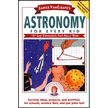To identify Earth’s Moon, it is generally capitalized. In this activity, the size of the celestial body, Ceres, is compared to the size of the Moon.
MAKE A MODEL COMPARING THE SIZE OF CERES TO THE MOON
1.Use a pencil and ruler to make two dots on a 12-inch (30-cm) square piece of poster board (card stock will work). Make one dot in the center of the poster board piece, which will be 6 inches (15 cm) from the edges. Make the second dot 3 inches (7.5 cm) from the first dot.
2. Using a drawing compass, draw a circle with a 6-inch (15-cm) radius. The center of this circle will be the dot in the center of the poster board.
3. Use the pencil and ruler to draw a line across the paper through the center dot. Label the line Moon- 2,200 miles (3,520 km).
4. Repeat steps 2 and 3 using the second dot as the center of a circle with a 1 ½ -inch (3.75-cm) radius. Label the line Ceres, 600 miles (950 km). This celestial body is big, but not as big as the Earth’s moon, which has a diameter of about 2,200 miles (3,520 km). In this activity, the scale used for the models is 1 inch (2.5 cm) = 183 miles (293 km).
5. Compare the size of the two circles. Notice how much smaller Ceres is in comparison to Earth’s Moon, which is smaller than Earth.
Just for Fun: The diagram has Chinese labels. Can you find the symbol for the kilometer (km) measurement?
Asteroids are relatively small, irregular, rocky chunks of matter which orbit the Sun. Until 2006, Ceres was considered to be the largest asteroid with a diameter of about 600 miles (960 km).
Why is Ceres considered a dwarf planet?
 |
Astronomy for Every Kid: 101 Easy Experiment That Really Work |